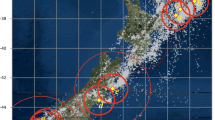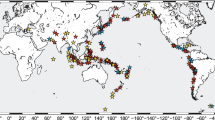Abstract
Complexity in the earthquake mechanism is manifested in different forms such as fractal distribution, clustering of seismicity, etc., and characterized as critical phenomenon. Occurrences of earthquakes generally represent the state of metastable equilibrium. The Andaman–Sumatra subduction zone is one of the most seismically active corridors (possibly in metastable state) in the world. Recently, the region faced three major earthquakes of magnitude more than 8.5 (M ~ 9.1 on December 26, 2004; M ~ 8.6 on March 28, 2005; M ~ 8.6 on April 11, 2012). Researchers have suggested multiple causes of earthquake generation in this region including the one with possible correlation of tidal stresses with earthquake occurrences. The latter issue, however, has been hotly debated in view of the fact that a small stress generated due to tidal forcing cannot cause such a bigger magnitude earthquake. We study here the impact of tidal forcing on critically generated earthquake phenomena. We examined the statistical behavior of recurrence time interval of earthquakes using the available data for period of about 40 years from 1973 to 2013. We constrain the simple empirical toy model using the concept of catastrophe theory to evaluate the impact of small tidal forcing on the critical state of earthquakes occurrences. In addition to the major role of Helmholtz free energy during the plate motion, our analysis suggests that the stability and critical behavior of the earthquake in Sumatra region could be associated with tidal forcing, however, only for triggering of some of the “Catastrophic–Chaotic” earthquake phenomenon.






Similar content being viewed by others
References
Beeler NM, Lockner DA (2003) Why earthquakes correlate weakly with the solid Earth tides: effects of periodic stress on the rate and probability of earthquake occurrence. J Geophys Res 108(B8):2391. doi:10.1029/2001JB001518
Blanpied ML, Lockner DA, Byerlee JD (1995) Frictional slip of granite at hydrothermal conditions. J Geophys Res 100(B7):13045–13064
Cattin R, Chamot-Rooke N, Pubellier M, Rabaute A, Delescluse M, Vigny C, Fleitout L, Dubernet P (2009) Stress change and effective friction coefficient along the Sumatra-Andaman-Sagaing fault system after the 26 December 2004 (Mw = 9.2) and the 28 March 2005 (Mw = 8.7) earthquakes. Geochem Geophys Geosyst 10:Q03011. doi:10.1029/2008GC002167
Chamoli A, Yadav RBS (2013) Multifractality in seismic sequences of NW Himalaya. Nat Haz (Online First)
Cochran ES, Vidale JE, Tanaka S (2004) Earth tides can trigger shallow thrust fault earthquakes. Science 306:1164–1166
Dieterich J (1979) Modelling of rock friction: 1. Experimental results and constitutive equations. J Geophys Res 84:2161–2168
Dieterich JH (1987) Nucleation and triggering of earthquake slip: effect of periodic stresses. Tectonophysics 144:127–139
Dimri, VP (2000) Application of fractals in earth sciences. A. A. Balkema, USA/Oxford and IBH Pub. Co., New Delhi
Dimri VP (2005) Fractals in Geophysics and Seismology- An Introduction. In: Dimri VP (ed) Fractal behaviour of the earth system. Springer, New York, pp 1–19
Ding Z, Jia J, Wang R (1983) Seismic triggering effect of tidal stress. Tectonophysics 93:319–335
Emter D (1997) Tidal triggering of earthquakes and volcanic events. In: Wilhelm H et al (eds) Tidal phenomena, Lect. Notes Earth Sci. (vol. 66). Springer, New York, pp 293–309
Gardner JK, Knopoff L (1974) Is the sequence of earthquakes in Southern California, with aftershocks removed, Poissonian? Bull Seismol Soc Am 64(5):1363–1367
Gomberg J, Raesenberg A, Bodin P, Harris RH (2001) Earthquake triggering by seismic waves following the Landers and Hector Mine earthquake. Nature 411:462–466
Heaton TH (1982) Tidal triggering of earthquakes. Bull Seismol Soc Am 72:2181–2200
Jiang C, Wu Z (2005) Test of the preshock accelerating moment release (AMR) in the case of the 26 December 2004 Mw 9.0 Indonesia earthquake. Bull Seismol Soc Am 95:2016–2025. doi:10.1785/0120050018
Kasahara L (2002) Tides, earthquakes, and volcanoes. Science 297(5580):348–349. doi:10.1126/science.1074601
King GCP, Stein RS, Lin J (1994) Static stress changes and the triggering of earthquakes. Bull Seismol Soc Am 84:935–953
Lockner DA, Beeler NM (1999) Premonitory slip and tidal triggering of earthquakes. J Geophys Res 104(B9):20133–20151
Lowry AR (2006) Resonant slow fault slip in subduction zones forced by climatic load stress. Nature 442(7104):802–805. doi:10.1038/nature05055
Metivier L, de Viron O, Conrad CP, Renault S, Diament M, Patau G (2009) Evidence of earthquake triggering by the solid earth tides. Earth Planet Sci Let 278:370–375
Morgan WJ, Stoner JO, Dicke RH (1961) Periodicity of earthquakes and the invariance of the gravitational constant. J Geophys Res 66(11):3831–3843
Perfettini H, Schmittbuhl J, Cochard A (2003) Shear and normal load perturbations a two-dimensional continuous fault: 2. Dynamics triggering. J Geophys Res 108:2409. doi:10.1029/2002JB001805
Poston T, Stewart I (1978) Catastrophe theory and its applications. Pitman, London
Ruina AL (1983) Slip instability and state variable friction laws. J Geophys Res 88:10359–10370
Rundle JB (1989) A physical model for Earthquakes 3. Thermodynamical approach and its relation to nonclassical theories of nucleation. J Geophys Res 94(B3):2839–2855
Savage MK, Depolo DM (1993) Foreshock probabilities in the western Great-Basin eastern Sierra Nevada. Bull Seismol Soc Am 83:1910–1938
Scholz CH (1998) Earthquakes and friction laws. Nature 391:37–42
Schuster A (1897) On lunar and solar periodicities of earthquakes. Proc R Soc Lond 61:455–465
Sornette D, Knopoff L, Kagan YY, Vanneste C (1996) Rank ordering statistics of extreme events: application to the distribution of large earthquakes. J Geophys Res 101(B6):13883–13893
Souriau M, Souriau A, Gagnepain J (1982) Modelling and detecting interactions between Earth tides and earthquakes with application to an aftershock sequence in the Pyrenees. Bull Seism Soc Am 72:165–180
Tanaka S (2010) Tidal triggering of earthquakes precursory to the recent Sumatra megathrust earthquakes of 26 December 2004 (Mw 9.0), 28 March 2005 (Mw 8.6), and 12 September 2007 (Mw 8.5). Geophys Res Lett 37:L02301. doi:10.1029/2009GL041581
Tanaka S, Ohtake M, Sato H (2002a) Spatio-temporal variation of the tidal triggering effect on earthquake occurrence associated with the 1982 South Tonga earthquake of Mw 7.5. Geophys Res Lett 29(16):1756. doi:10.1029/2002GL015386
Tanaka S, Ohtake M, Sato H (2002b) Evidence for tidal triggering of earthquakes as revealed from statistical analysis of global data. J Geophys Res 107(B10):2211
Tolstoy M, Vernon FL, Orcutt JA, Wyatt FK (2002) Breathing of the seafloor: tidal correlations of seismicity at Axial volcano. Geology 30:503–506
Tsuruoka H, Ohtake M, Sato H (1995) Statistical test of the tidal triggering of earthquakes: contribution of the ocean tide loading effect. Geophys J Int 122:183–194
Vidale JE, Agnew DC, Johnston MJS, Oppenheimer DH (1998) Absence of earthquake correlation with Earth tides: an indication of high preseismic fault stress rate. J Geophys Res 103:24567–24572
Wilcock WSD (2001) Tidal triggering of microearthquakes on the Juan de Fuca Ridge. Geophys Res Lett 28:3999–4002. doi:10.1029/2001GL013370
Yin XC, Wang YC, Peng KY, Bai YL, Wang HT, Yin XF (2000) Development of a new approach to earthquake prediction: load/unload response ratio (LURR) theory. Pure Appl Geophys 157:2365–2383. doi:10.1007/PL00001088
Acknowledgments
We thank Director, CSIR-NGRI for support and permission to publish the work.
Author information
Authors and Affiliations
Corresponding author
Rights and permissions
About this article
Cite this article
Tiwari, R.K., Chamoli, A. Is tidal forcing critical to trigger large Sumatra earthquakes?. Nat Hazards 77 (Suppl 1), 65–74 (2015). https://doi.org/10.1007/s11069-014-1068-9
Received:
Accepted:
Published:
Issue Date:
DOI: https://doi.org/10.1007/s11069-014-1068-9




